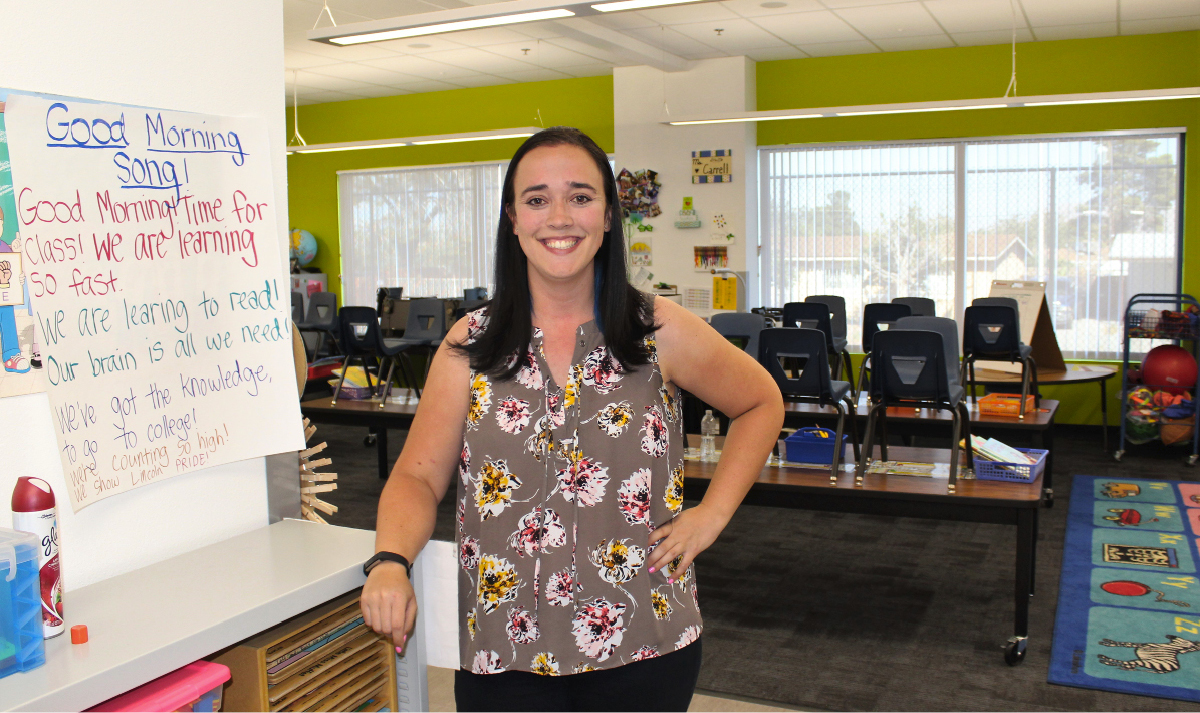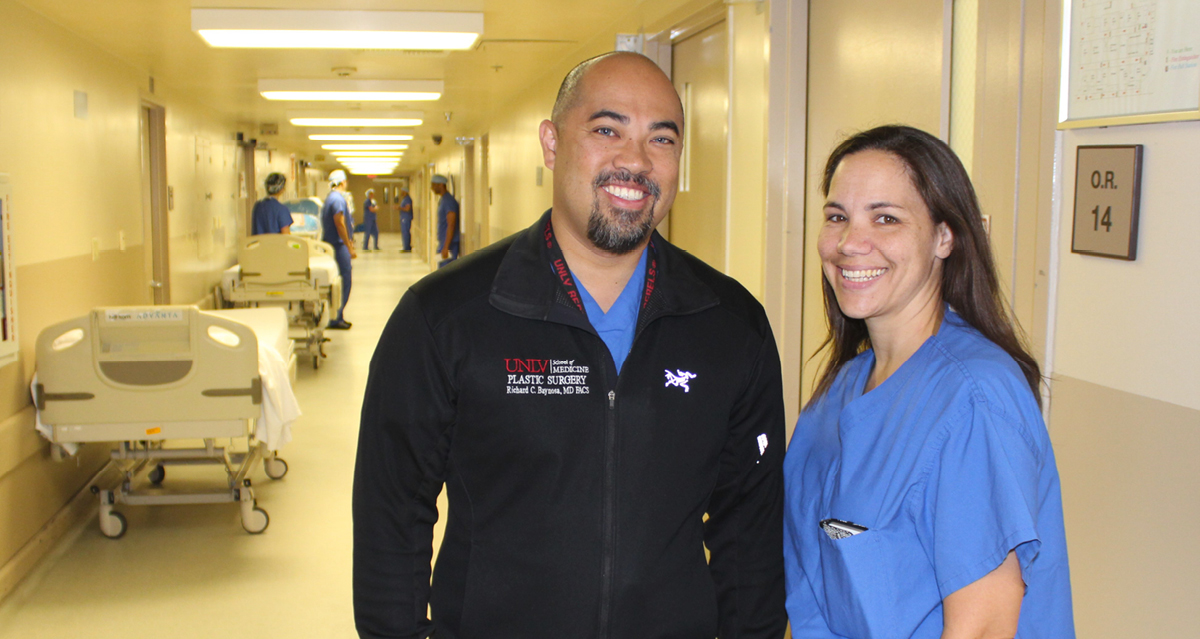Stephanie’s Choice

Anxiety, the kind that makes your heart race, that repeatedly gives birth to the question ”What if?” – Stephanie Carrell knows all about it. She should. Since she was 14, she’s discovered more than 20 lumps in her breasts.
And over the last 18 years, she’s had each lump biopsied.
“The process of waiting each time to see (if a new lump was cancerous) made me anxious,” she said recently over breakfast on the outdoor patio of an eatery in Summerlin’s Trailwoods Center not far from her home. “I learned it’s OK to cry and be overwhelmed sometimes...I’m very fortunate that there’s been no cancer.”
Now a highly respected 32-year-old kindergarten teacher at Lincoln Elementary School in North Las Vegas – her ready humor with children and colleagues flies in the face of her medical challenges – the 5-foot 11-inch Carrell had a preventive double mastectomy in June.
The procedure, at University Medical Center, by UNLV Medicine Surgical Oncologist Dr. Jennifer Baynosa, should greatly minimize Carrell’s risk of getting breast cancer, which, because of a rare genetic mutation, had been as high as 85 percent.
“Her risk now is in the single digits,” says the 41-year-old Baynosa, a UNLV School of Medicine Associate Professor who completed a breast surgery fellowship at Stanford. “She has a lot of courage...It’s a big step to lose your breasts so young, especially when no cancer is present.”
Since Breast Cancer Awareness Month began in October 1985, many who’ve dealt with the disease, which is still killing 40,000 Americans each year, have shared their stories. They hope that by keeping a spotlight on a scourge spawning more than 260,000 new cases each year, women will realize a better sense of how to cope with the disease – and they pray the search for a cure is pursued with a greater sense of urgency. And now Stephanie Carrell wants to add her voice.
“If I can help just one woman with my story, I’ll feel I’ve accomplished something,” she said. “In this process you can feel all alone real quick. You can spend too much time in your own head and that’s dangerous.”
Until Carrell was 25, no medical practitioner had any idea why she developed growths in her breasts, or lesions on her hands and tongue. It was the persistence of Louise Erps, Carrell’s mother, that actually led to the answer of “Why?”
“Whenever my mother would talk to any doctor, she would bring up my symptoms, including the fact that I was born with a somewhat larger head,” Carrell recalled. “One day she took my grandmother to a doctor and mentioned my symptoms to him and he suggested I should have genetic testing for Cowden’s Syndrome (CS).”
The suggestion was followed and testing showed Carrell, did, indeed, have CS, a genetic syndrome caused by a mutation in a gene called PTEN. While neither of her parents had the mutation, the mutation may occur in either the egg or the sperm from which they were conceived. It is not the result of something happening or not happening during pregnancy, nor is it preventable. Characteristics of the syndrome include skin and mouth lesions, breast growths, a larger head, and thyroid and gynecologic problems. Doctors say Cowden’s is often underdiagnosed because individuals may only possess a few of the syndrome’s characteristics. Researchers have found the greatest cancer risk for a woman with CS is breast cancer, with a lifetime risk estimated between 50-85 percent. The risk of thyroid and kidney cancer is above 30 percent for both men and women with CS.
At about the time Carrell was diagnosed with CS in 2008, she developed a large growth on her thyroid. Though it was not found to be cancerous, Carrell had her thyroid removed as a preventive measure. “I just did not like the idea of having a needle stuck in my neck area from time to time for a biopsy to check if I had cancer,” said Carrell, who already had the lesions removed from her hands. “I could see something happening where I couldn’t talk.”
Carrell’s mother, afraid of losing her daughter, also thought Carrell should then have a preventative double mastectomy, which doctors said could greatly reduce the chances of breast cancer. But Carrell wasn’t ready.
“I just didn’t want to lose that part of myself then,” she said. “It’s a very difficult decision to make. I’m not married or have a boyfriend but I want to and I want to be as natural as possible...I didn’t stick my head in the sand. I continued with the frequent screenings every six months, including more frequent mammograms. And I stayed abreast of the most current research by establishing myself with the Cleveland Clinic in Ohio CS genetics team. I’ve learned that many women only find out they have CS when they’re diagnosed with breast cancer. They get a double whammy. I was lucky. I had time to process what I was going to do. I think most women would appreciate that.”
In the last year, she decided to stop what she calls the “gamble” with her life and have the prophylactic bilateral mastectomy along with plastic surgery reconstruction. She decided to interview doctors. It was important to her to not only have skilled doctors, who could work well together, but also doctors who didn’t have hearts of stone, who couldn’t even muster up empathy for a woman trying to reduce her cancer risk. She had become all too familiar with them during the biopsy process. Once, a doctor told her that her mother – who had frequently provided essentially hand-holding moral support – couldn’t be in the room with her during the process because they didn’t want to have to hassle with her should she faint and fall on the floor. When Carrell started to tear up in front of another doctor, he told her she’d have to leave immediately if she was going to cry. “You learn a lot about doctors and about yourself when you go through this,” she said.
It’s 4:30 on a Wednesday afternoon. As she’s done once a week since her June procedure, Carrell meets with Dr. Richard Baynosa, the chief and program director of the division of plastic surgery at the UNLV School of Medicine. He makes sure the healing process is going well following the surgery performed by his wife, Dr. Jennifer Baynosa. Patient and physician have an easy familiarity as Baynosa shows her the silicone implants that will be part of her breast reconstruction. “How do you like these?” he says. “They’ll work fine,” she replies, grinning.
The Baynosas, who married in 2008, met while completing surgical residencies at the University of Nevada, Reno School of Medicine. He also trained in Belgium with world-renowned plastic surgeon Dr. Phillip Blondeel, the originator of DIEP free flap reconstruction, a complex procedure that involves taking a section of tissue from one area of a woman’s body – most often her abdomen – and relocating it to create a new breast mound. Baynosa became the first surgeon in the state of Nevada to offer DIEP reconstruction and, in his role as an associate professor at the UNLV School of Medicine, has since trained several residents in the technique.
Carrell first heard about the Baynosas during interviews she conducted with plastic surgeons. To have a more natural reconstruction, she told them she wanted nipple sparing mastectomies, which begin with a surgeon removing, through small incisions, all of the tissues from beneath the overlying skin and nipples. The breast envelope and nipple are left intact. Given the condition of her breasts, breast lifts would also be required. While two plastic surgeons did not think her request was feasible, one plastic surgeon said Baynosa had the background to do it. “Dr. Baynosa told me it would be difficult, but it was doable,” she said.
When Carrell found out that Baynosa worked closely with his wife on breast cases, she was overjoyed. “From my research, I knew how important it was that the surgical oncologist and plastic surgeon work closely together.” In fact, it was Baynosa who drew the markings on Carrell prior to the bilateral mastectomy so his wife would know exactly where to create the breast envelopes for the best reconstruction result. When she finished, he inserted temporary tissue expanders – soft balloon-like devices filled with air to create spaces for the implants he will imbed in about a month. What makes this reconstruction particularly challenging is that a blood supply to the nipples must be maintained.
“I’ve been so thankful that both Baynosas have given me their personal emails so I can ask them questions and I get answers back quickly,” Carrell says. “And when I’m with them, they listen. They’re both very busy but they never act like I’m taking up their time. They never seem like something I’m asking is dumb.”
We’ve talked at the restaurant for two hours. Carrell stresses how important it is to have a solid support team of doctors and relatives when you have a condition that too often serves up unwanted surprises. She rattles off the names of Drs. Richard and Jennifer Baynosa and of family, in addition to her mother, who keep her seeing the glass as half full, rather than half empty – her father, John Carrell, stepdad, Dan Erps, stepmom, Dianna Carrell, sister, Jaclyn Winter, brother-in-law, Chris Winter, niece, Josalynn Winter, nephew Brandon Winter. They always show up or get on the phone when she needs a lift.
“You can’t go through something like this alone,” she says. “If you spend too much time in your own head thinking, it’s not healthy.”

Dr. Richard & Dr. Jennifer Baynosa.
